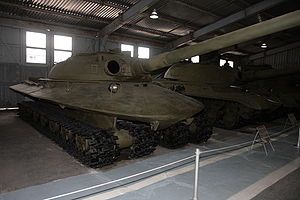- Object 279
-
Object 279 
Object 279, Kubinka tank museum (2008)Type Heavy tank Place of origin  Soviet Union
Soviet UnionProduction history Produced 1959 Number built 1 Specifications Weight 60 metric tons Length 6,770 mm length 11,085 mm (with the gun) Width 3,400 mm Height 2,639 mm Crew 4
Driver
Loader
Gunner
CommanderArmor 319 mm - 217 mm (turret front and side)
(at 30° - 50° from vertical)
269 mm - 93 mm (upper hull front)
(at 45° - 75° from vertical)
258 mm - 121 mm (lower hull front)
(at 45° - 70° from vertical)
182 mm - 100 mm (hull side)
(at 45° - 65° from vertical)Main
armament130 mm M-65 rifled gun L/60
(40 rounds)Secondary
armament14.5 x 114 mm KPVT coaxial machine gun
(800 rounds)Engine 2DG-8M diesel engine
1000 hpOperational
range300 km Speed 55 km/h Object 279 (Объект 279) was a Soviet experimental heavy tank developed at the end of 1959.
This special purpose tank was intended to fight on cross country terrain, inaccessible to conventional tanks, acting as a heavy breakthrough tank, and if necessary withstanding even the shockwave of a nuclear explosion. It was planned as a tank of the Supreme Command Reserve.
Contents
Design
The tank was developed at the Kirov Industrial Plant, Leningrad, by a group headed by the engineer L. Troyanov. The work on the tank started in 1957, which was based on a heavy tank operational requirements developed in 1956, and a pre-production tank was completed at the end of 1959. [1]
This unique tank boasted increased cross-country capability. It featured four-track running gear mounted on two longitudinal, rectangular hollow beams, which were also used as fuel tanks. The tank suspension was hydro-pneumatic with complex hydrotransformer and three-speed planetary gearbox. The track adjuster was worm-type. The specific ground pressure of this heavy vehicle did not exceed 0.6 kgf/cm2. The track chain, running practically along the whole track length provided for increased cross-country capabilities on swampy terrain, soft soils and area full of cut trees, Czech hedgehogs, antitank obstacles and the like.
The tank was equipped with the powerful 1000 hp 2DG-8M diesel engine, enabling the 60 metric ton tank to attain 55 km/h speed, with active range of 300 km on one refuel. It also had an auto fire-fighting systems, smoke laying equipment and combat compartment heating/cooling system.
Armour
The tank hull, with a maximum armor thickness of 269 mm, was covered by a thin, elliptical shield protecting it against APDS and shaped charge ammunition, and preventing it from overturning by the shockwave in case of a nuclear explosion. It comprised large cast irregular shape structures of variable thickness and slope. The all-cast front part of the hull was rounded in shape with thin armour panels against HEAT projectiles, which ran around the edges of the front and sides of the hull. The sides of the hull were also cast and had similar protective armour panels.
The all-cast turret, with a maximum armor thickness of 319 mm [2], was rounded and had anti-HEAT protective panels. The turret ring was also heavily protected. The tank was equipped with a chemical, biological, radiological, and nuclear (CBRN) protection.
Armament
The tank was armed with the 130 mm M-65 rifled gun, firing APDS rounds with a muzzle velocity of 1000 m/s, for the 33 kg armor-piercing tracer shell, and a maximum armor penetration of 450 mm of rolled homogeneous armour (RHA) at 90°. The secondary armament was a 14.5 x 114 mm KPVT coaxial machine gun with 800 rounds.[3] The weapons were stabilized in two planes by a "Groza" stabilizer. Object 279 carried 40 rounds of ammunition, with charge and the shell to be loaded separately.[4]
The gun was provided with a semi-automatic loading system with a rate of fire of 5-7 rounds/min. Firing control system comprised optical/radar rangefinder, auto-guidance system and L2 night-sight with an active infrared searchlight.
An improved variant of the gun was later, late 1970s, tested on the experimental tank Object 785.
History
One of the reasons this tank project to be abandoned, as other heavy tank projects, was the fact that the Russians stopped operating with heavy fighting vehicles of that type, tanks and similar, as of 1960. Since then, the heaviest ones are kept at about 50 metric tons of weight, that is without counting in any additional equipment such as additional reactive armor, mine clearing devices (mine ploughs, mine rollers) etc. It was something concerning the current Soviet policy ("А 22 июля 1960 г. на демонстрации новой техники на полигоне Капустин Яр Н. С. Хрущев категорически запретил прием на вооружение любых танков массой более 37 т, тем самым поставив крест на всей программе тяжелых танков, оказавшейся столь результативной" / On July 22, 1960 at the demonstration of new technology on the range of Kapustin Yar, Nikita Khrushchev strictly forbade any tanks with a weight of more than 37 metric tons to be adopted by the military, having thus written off the entire program of heavy tanks which proven to be so successful).[2]
Nikita Khrushchev himself was a supporter of guided missile tanks, which apparently added to the decision, the most prominent of which was the Object 775.
Furthermore, the Russians wanted tanks with a suitable weight for crossing their own bridges, in case of a homeland defence situations similar to the World War II ones, which at that time seemed to be unreliable for heavy vehicle crossings.
Other reason was the fact that a number of serious deficiencies of the running gear appeared during the trials. Low nimbleness, efficiency loss during swampy area crossings, complex and expensive production, maintenance and repair, and impossibility of reduction in the overall height of the tank.[5]
References
Categories:- Cold War Soviet tanks
- Heavy tanks of the Cold War
- Trial and research tanks
- Abandoned military projects of the Soviet Union
- Heavy tanks of the Soviet Union
Wikimedia Foundation. 2010.
